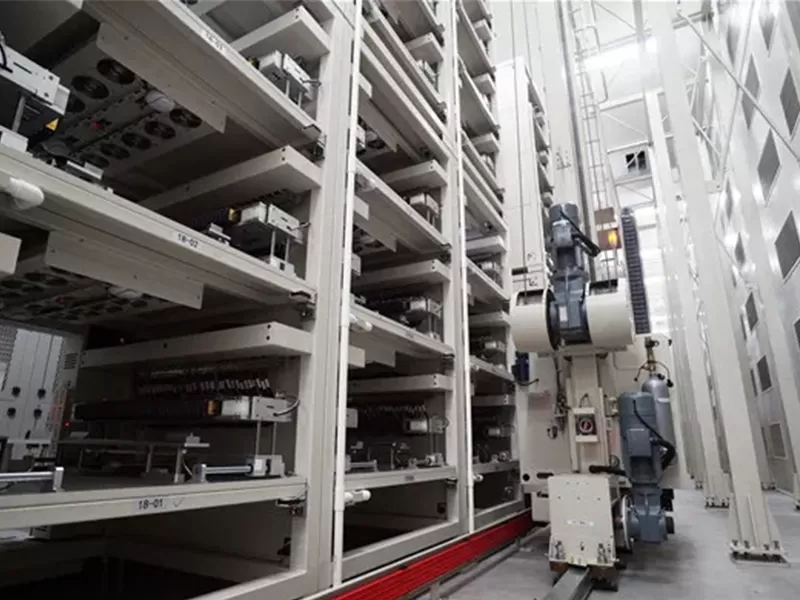What Are AGV Carts?
AGV carts are automated mobile platforms designed to transport goods, raw materials, or products within a factory or warehouse. Equipped with navigation systems such as laser guidance, magnetic tape, or vision-based navigation, AGV carts can move autonomously between predefined stations.
Key Features of AGV Carts for Battery PACK Factories
High Load Capacity:
AGV carts are built to carry heavy battery modules and PACKs, with typical load capacities ranging from 500 kg to over 2,000 kg, depending on the design.
Customizable Design:
AGVs can be tailored for different applications, such as flatbed carts, pallet movers, or carts with shelves for stacked battery storage.
Precise Navigation:
Advanced guidance systems ensure precise movement and positioning, crucial for tight spaces in battery PACK factories.
Battery-Powered Operation:
AGVs themselves use efficient batteries with long operational times and quick charging options to support continuous operation.
Integration with MES/ERP Systems:
Real-time integration with Manufacturing Execution Systems (MES) or Enterprise Resource Planning (ERP) systems for automated task scheduling and inventory management.
Safety Features:
Equipped with sensors, cameras, and obstacle detection systems to ensure safe operation around workers and other machines.
Applications of AGV Carts in Battery PACK Factories
Raw Material Transport:
AGVs handle the movement of battery cells, cases, and other components from the storage area to the production line.
Work-In-Progress (WIP) Transfers:
Transport semi-assembled battery modules or PACKs between different stations, such as welding, testing, and assembly lines.
Finished Goods Handling:
Move completed battery PACKs to storage or shipping areas efficiently.
Waste and Scrap Management:
AGVs can also transport defective components or waste materials to designated disposal or recycling areas.
Benefits of Using AGV Carts in Battery PACK Factories
Enhanced Productivity:
Automation reduces manual handling time, ensuring smoother and faster operations.
Scalability:
AGV fleets can be easily expanded as production needs grow, providing flexibility in scaling operations.
Improved Safety:
Reduces the risk of workplace accidents by eliminating manual forklift usage or human-operated carts.
Lower Operating Costs:
AGVs are energy-efficient and reduce reliance on labor for repetitive tasks, minimizing operational expenses.
Increased Traceability:
Integration with MES/ERP systems enables precise tracking of materials and goods throughout the factory.
Space Optimization:
AGVs operate efficiently in tight spaces and require minimal infrastructure, optimizing factory layouts.
Types of AGV Carts for Battery PACK Factories
Flatbed AGVs:
Used for transporting pallets or large battery modules directly.
Tugger AGVs:
Pull carts or trolleys with multiple loads, ideal for transferring materials in bulk.
Shelf-Carrier AGVs:
Equipped with adjustable shelves for carrying smaller components or stacked modules.
Robotic Forklifts:
Capable of lifting and placing pallets or battery racks onto high storage shelves.
Hybrid AMRs (Autonomous Mobile Robots):
Combine AGV capabilities with advanced navigation for more flexible material handling.
Considerations for Implementing AGVs in Battery PACK Factories
Navigation and Layout:
Ensure the factory layout supports AGV pathways, with clear markings for navigation (magnetic strips, QR codes, or laser reflectors).
Charging Infrastructure:
Implement docking stations for fast and convenient battery recharging or swapping.
Load Compatibility:
Design AGVs to handle specific weights and dimensions of battery modules or PACKs.
Software Integration:
Ensure seamless communication between AGVs, MES, and other automation systems for efficient task allocation.
Environmental Controls:
Maintain suitable temperature and humidity levels for AGVs, especially in environments with battery-sensitive materials.
Leading Vendors of AGV Solutions
Some prominent manufacturers of AGV systems for battery factories include:
· KUKA Robotics
· Daifuku
· Omron
· Geek+
· MiR (Mobile Industrial Robots)
The Role of AGVs in Smart Battery PACK Factories
As battery production shifts toward Industry 4.0 principles, AGVs play a pivotal role in achieving intelligent, automated, and highly efficient workflows. They help reduce labor costs, improve operational safety, and ensure seamless material flow across all stages of production.







